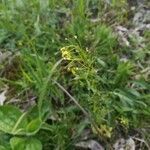Annuals; not scapose. Stems unbranched or branched proximally, (0.3-)0.6-4.5(-6) dm, densely pubescent proximally, glabrous distally, trichomes simple, 0.5-1.3 mm, and stalked, 2-4-rayed, 0.1-0.5 mm. Basal leaves rosulate or not, petiolate; petiole ciliate throughout; blade oblong-obovate or oblanceolate, (0.4-)1-3.5(-5) cm × (2-)5-15(-20) mm, margins usually dentate to denticulate, rarely subentire, surfaces sparsely to densely pubescent with stalked, 2-or 3-rayed, and cruciform trichomes, 0.1-0.5 mm. Cauline leaves 4-12(-15); sessile; blade broadly ovate to oblong, margins dentate or denticulate, surfaces pubescent, abaxially as basal, adaxially with primarily simple, and 2-or 3-rayed trichomes. Racemes (10-)18-60(-92)-flowered, ebracteate, considerably elongated in fruit; rachis not flexuous (straight), glabrous. Fruiting pedicels divaricate, straight, 7-28 (-35) mm [(1.5-)2-7 times longer than fruit], glabrous. Flowers: sepals ovate, (0.7-)0.9-1.6 mm, sparsely pubescent, (trichomes simple); petals yellow, spatulate to oblanceolate, (1.2-)1.7-2.2(-2.5) × (0.4-)0.6-1 mm, (deeply notched); anthers broadly ovate to subreniform, 0.1-0.2 mm. Fruits oblong to elliptic or, rarely, oblong-oblanceolate, plane, slightly flattened, (3-)5-8 (-10) × 1.5-2.5 mm; valves glabrous or puberulent, trichomes simple, antrorse, 0.05-0.2 mm; ovules (30-) 36-60(-72) per ovary; style 0.01-0.1 mm. Seeds ovoid, 0.5-0.7(-0.8) × 0.3-0.4(-0.5) mm. 2n = 16.
Annual or winter-annual to 3 dm; basal lvs lance-ovate to oval, elliptic, or obovate, 1–2.5 cm; cauline lvs similar, few to several, all below the middle of the stem, often dentate, pubescent with simple and branched hairs; pet yellow, turning white in age, 2 mm; mature raceme loose and elongate, to 2 dm, glabrous, with widely spreading or ascending glabrous pedicels to 3 cm; frs ascending to erect, glabrous or hirsutulous, linear-oblong, 5–10 mm; 2n=16. Dry soil, prairies, and hillsides; widespread in Eurasia and much of w. N. Amer., extending e. to Lake Superior and locally in Mich. and sw. Que. (D. lutea)
Annual herb 10–30, rarely to 40, cm tall, ascending to erect, with stellate and simple hairs. Basal leaves in a rosette, ovate to obovate to oblanceolate, to 15 mm long, petiolate, coarsely dentate; cauline leaves reducing in size, sessile towards apex. Sepals with simple hairs. Petals 1–3 mm long, white to cream. Stamens 6. Silicula elliptic to ovate, 3–8 mm long, compressed parallel to septum; valves with simple hairs; pedicels slender, spreading, longer than silicula, to 20 mm long. Seeds elliptic, c. 0.75 mm long, 6–12 per locule.
A cabbage family herb. It is an annual plant up to 45 cm tall. The leaves at the base are in a ring. They are 1-4 cm long by 2-12 mm wide. They do not have leaf stalks but have 3-6 teeth near the tip. The flowers are 2 mm across and pale yellow. They are in large groups.


